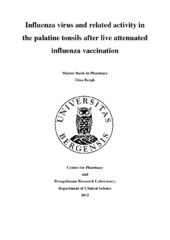| dc.description.abstract | Influenza is a common infection in humans, with annual outbreaks. It can cause severe disease and have great socioeconomic impact. Children are more susceptible to infection than adults, especially when they have a naïve immune system. Two types of influenza vaccines are in the market; the inactivated influenza vaccine and the live attenuated influenza vaccine (LAIV). LAIV is administered intra-nasally and discards the use of needles. It is the preferred vaccine for immune naïve children, with the highest efficacy in children aged from 6 months to 7 years. The present work focus on the influenza antigen from the LAIV in tonsillar tissues of children aged 3-17 years. In the first part of the work, we assessed whether the influenza virus from LAIV is able to replicate in the tonsillar tissue homogenate of these patients. In the second part, the influenza-specific antibody secreting cells (ISASC) were counted in tonsillar tissue sections from samples of 20 patients, to assess the differences between vaccinated and unvaccinated subjects. The methods used were UV-spectrophotometry to assess the quality and quantity of vRNA, reverse transcription q-PCR to determine whether LAIV replication occurred in the tonsils and fluorescent labeling of influenza antigen followed by microscopic detection of the ISASCs to compare the ISASCs between the subjects based on vaccine status. We found the vRNA quality and quantity to be satisfactory for downstream experiments. The PCR determined that the patient samples were negative for replicating influenza virus, while the positive controls were positive. In the second part we found that all tonsil sections were positive for influenza specific ASCs, and that the largest densities of these were found in the extra follicular zones. The ASCs of the unvaccinated patients were fewer and the number of ASCs in this group of patients were not so scattered. More ASCs were found in the vaccinated patients, and the number of ASCs varied more in this group. Based on the results, the conclusion is that the LAIV does not replicate in the tonsils. The hypothesis that the dendritic cells transport the virus antigen to the tonsillar tissue have become stronger. The ISASCs were found in all tonsil sections, indicating that none of the patients were immune naïve to the H1N1 antigen. Nevertheless, differences were found between the vaccinated subjects and the unvaccinated controls. This strongly indicates that the viral antigen from the vaccine have affected the production of antibodies in the tonsil tissues | en_US |
